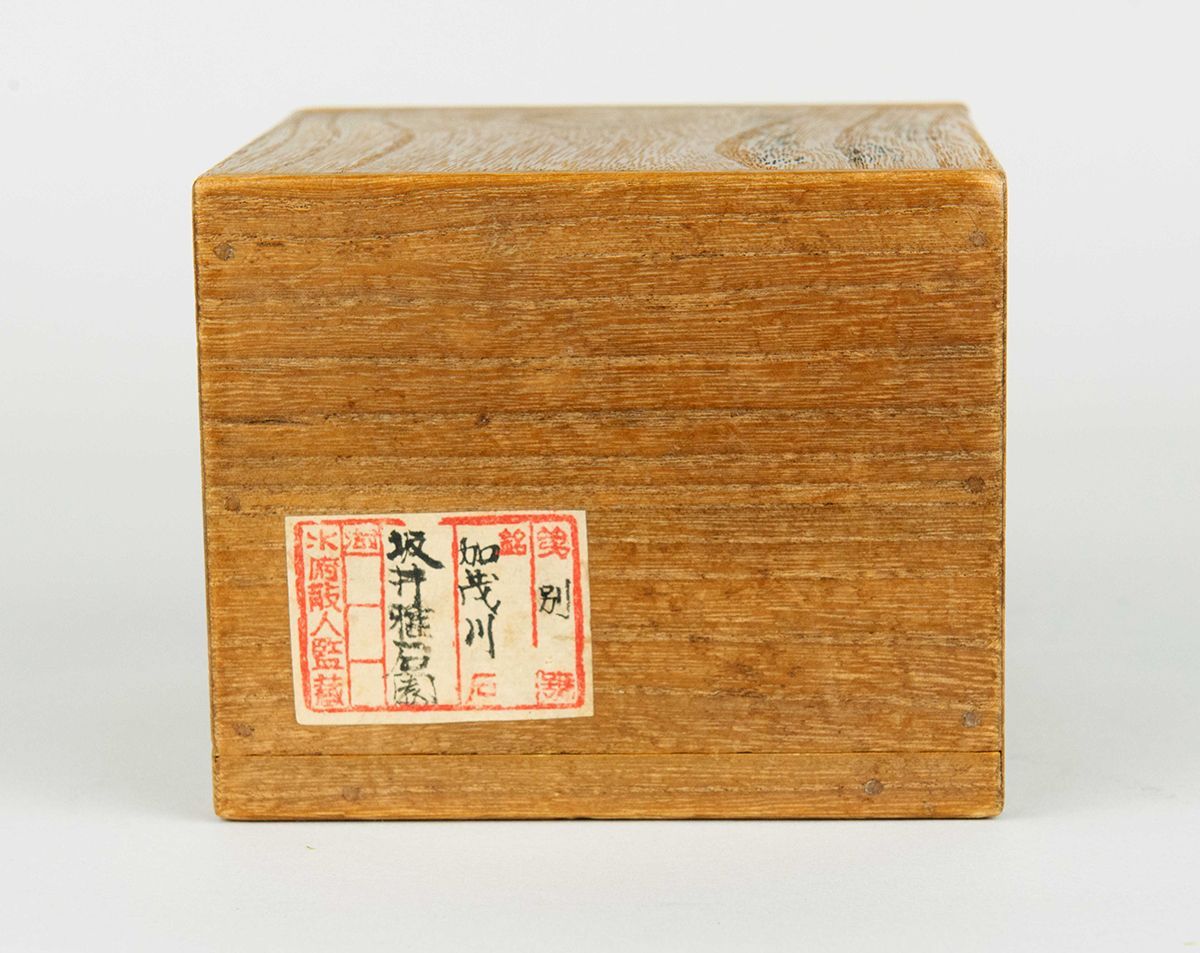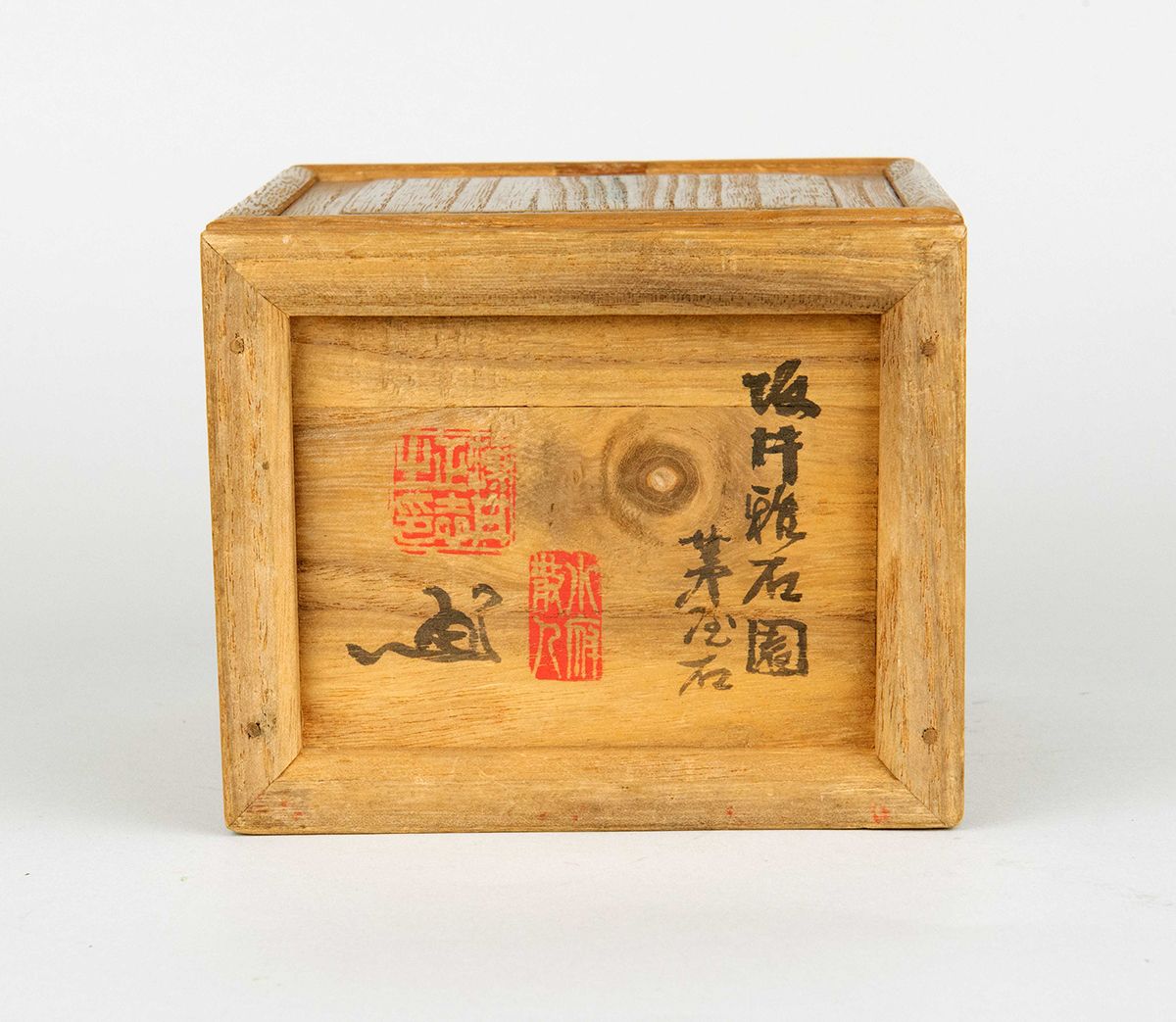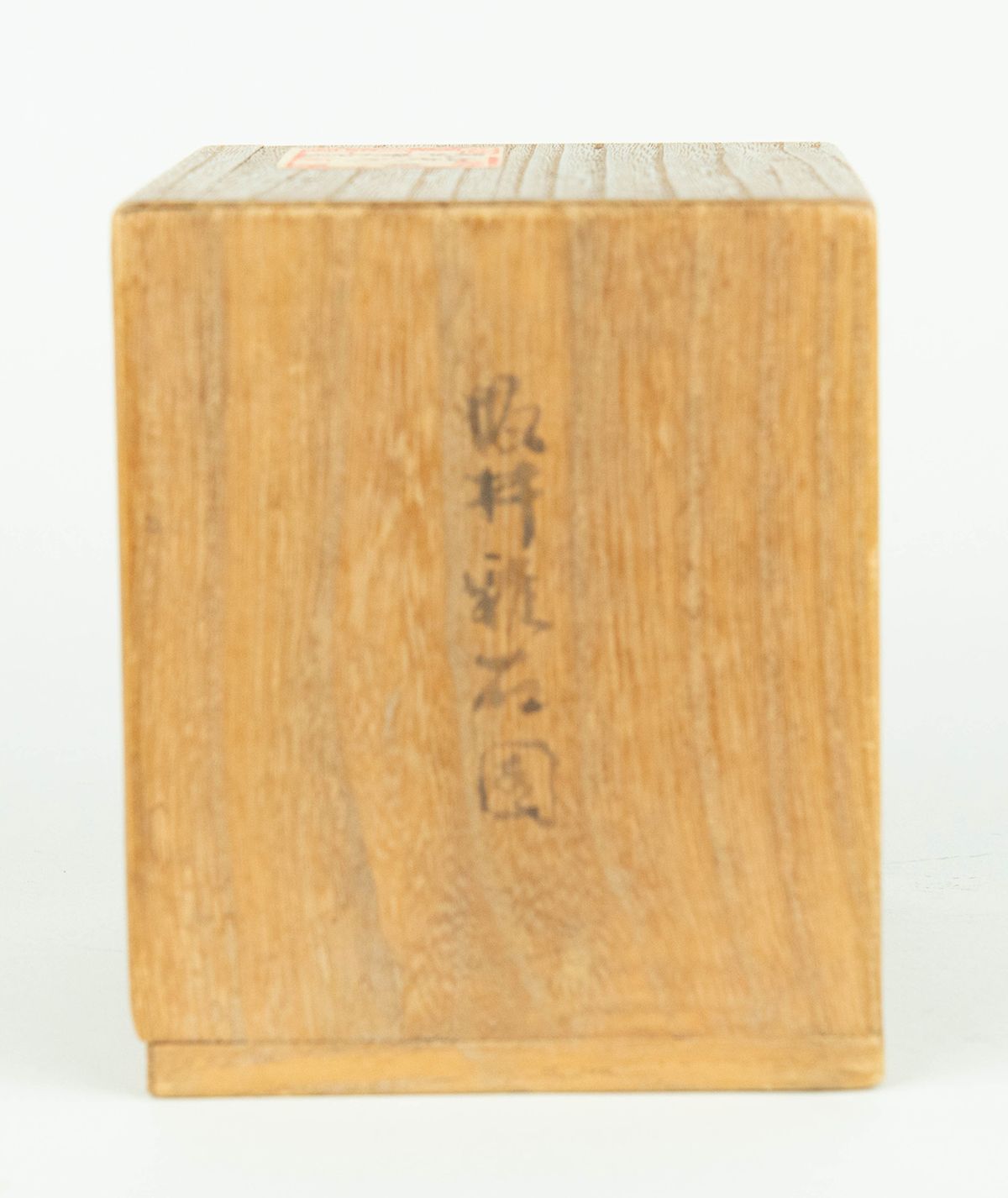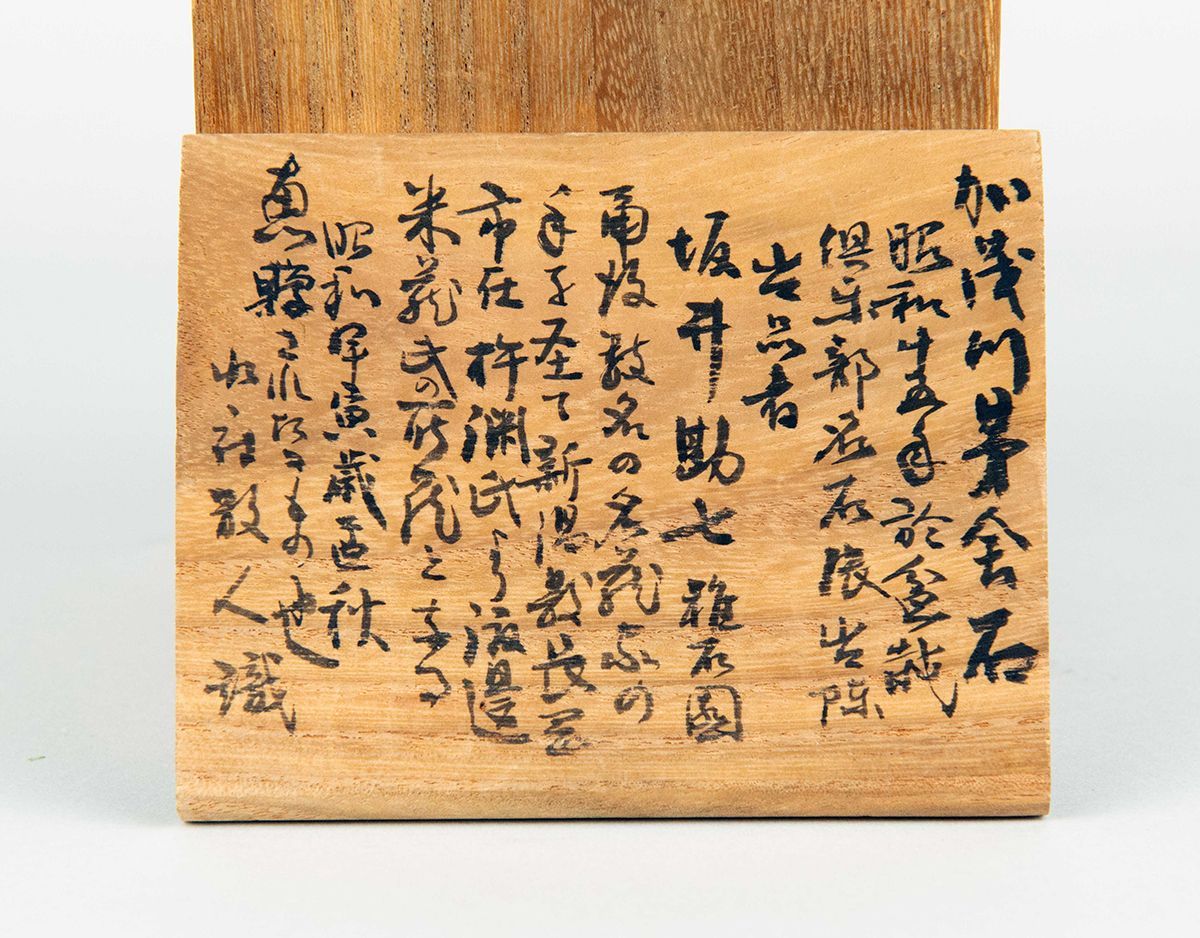What Makes a Stone Exceptional? A Look at a Special Stone
Kamo River Hut stone enhanced by Sakai Kanhichi
By Thomas S. Elias July, 2023
Last year, I had the opportunity to acquire a small but exciting stone that came from Gaseki-en with a nearly 100-year-old provenance. This stone was enhanced by Sakai Kanhichi, one of the early stone carvers in Japan. I wrote about the Sakai family several years ago; owning one of their stones was a long-time dream. The features, front and back, of this rustic hut stone, were in perfect proportions, and the black color of this Kamo River stone evoked a calm, peaceful feeling of an older mountain home showing the effects of decades of weathering. Holding this stone in my hand, I felt a connection between this lithic element and my life.
This stone came in an older storage box, a
kiri bako, with abundant box writing, seals, and labels. This information contained the provenance of this stone. Knowing the history and who owned it over time added meaning to this stone. There is writing on all sides as well as the top and bottom. There is even a removable panel inside the box, both sides of which are inscribed with information about the origin of the stone, who owned it, and when it was exhibited. This type of specific detailed information is rarely encountered in Japanese suiseki practices. (Below front and back).
It is a small stone measuring 8.5 cm wide, 6.3 cm high, and 5.5 cm wide without the base, and weighs 325 grams. The professionally made wood base with seven tiny short legs is unsigned.

The kiri bako is made from the lightweight but durable wood of the Paulownia tree, Paulownia tomentosa. This fast-growing tree is native to East Asia is also known as the Empress Tree. Fresh or new Paulownia wood is light in color, but darkens considerably as it ages over several decades. Thus, we can tell this is an old storage box. The writing on the face of the sliding panel on the front of the box translates “Kamo River Kuzuya-ishi.”

A label on the top of the box provides added information. This is a label or a storage tag was used by the well-known collector Suifu Sanjin for stones in his personal collection (red ink, left column). Suifu Sanjin is an artist name used by Usui Tadashi (1921-1994), who collected suiseki, bonsai pots, and seals. He is also known for his box writing. The words in black ink in the third column from the left read “Sakai Gaseki-en” or Gaseki Stone Garden. Kamogawa-ishi is written in black ink in the fourth column from the left. The far-right column is translated as “storag number.” It is not clear what this means. However, this storage tag tells us that Suifu Sanjin once owned this stone, and it also leads us to an earlier owner, the Sakai Gaseki Garden.


The writing on the bottom consists of two columns of text with two seals and a
Kaou ( ) or monogram in the lower left. The first column on the right in black ink translates “Sakai Gaseki-en, while the shorter second column translates “Kuzukya-ishi.” The two seals and the monogram are attributed to Sunifu Sanjin. The box writing on the exterior right side simply states, “Sakai Gaseki-en.” The reason this repeats the information provided on the top tag and the bottom is unclear.
Back of the front opening panel
A poem written on the backside of the front panel translates:
When I look at this stone
I feel as if I was in my dream,
Sleeping for the last 40 years
Now I am awake and I feel foggy
Shiryui
According to Japanese Suiseki scholar Nakagawa Mikio, the name”Shiryu” is another artist name for Sanjin. According to Nakagawa, this name, Shiryu, appears on many box writings. He also informed us that this writing was done when Sanjin was 46 years old in 1975 or 1976. (Or would that be 1974 or 1975?).
Perhaps the most informative panel is the one inserted inside the storage box. The writing was done by Suifu Sanjin. One side on the front of the panel is translated:
“In 1940 Bonsai Club Masterpieces Exhibition, exhibited by Sakai Kanhichi of Gaseki-en. This stone was owned by a few stone connoisseurs and by Mr. Kinebuchi, Chief Judge of Niigata Court (this stone), then by Watanabe Yonezou. In the autumn 1974, I acquired (this stone).
Suifu Sanjin learned”
The writing on the other side of the panel translates:
“About the creator, Sakai Kanhichi, at Gaseki-en. He ran a business of order-made suiseki and introduced many masterpieces to the world. He was handicapped with his left arm distorted. He used Akadama-ishi etc., to make and process (suiseki) skillfully and precisely. He died in 1945 due to the (WWII Tokyo) bombing.”
This historical account of this stone is truly exciting. It is rare to find such extensive data with a stone and its box. And it is even more exciting when it relates to some of our previous research and writing on Japanese suiseki. In 2016, Hiromi Nakaoji and I published a paper, Enhancing the Stone. Part 1, The Japanese Reality of Modifying Suiseki. In this article, we discussed the Sakai family of stone carvers and merchants in detail. Sakai Teikyo and his two sons, Sasuke and Kanhichi, began working stones between 1891 and 1907 by altering the bottom so they would sit better. They expanded beyond that and began carving suiseki from certain types of stones, especially from the Ibi River. In 1924, Sakai Kanchichi, the second son of Sahichi, opened a stone shop in Tokyo and named it Gaseki-en. They made and sold many excellent mountain-shaped suiseki, including ones made from two-toned (black and whitish) that Mr. Yojuro collected. These later became known as Yojuro stones.
The information from this box tells us that Gaseki-en existed until at least 1940. Hundreds of enhanced stones were sold to collectors throughout Japan during this sixteen-year period.
Having a stone that was carved by Sakai Kanhichi roughly 100 years ago adds considerably to the meaning and value of this new acquisition. An outstanding stone, even if it has been enhanced, accompanied by the story behind this stone, combines to make it truly a special stone. We will treasure this gem while it is in our possession and eventually pass it on to another collector who will become its guardian.


